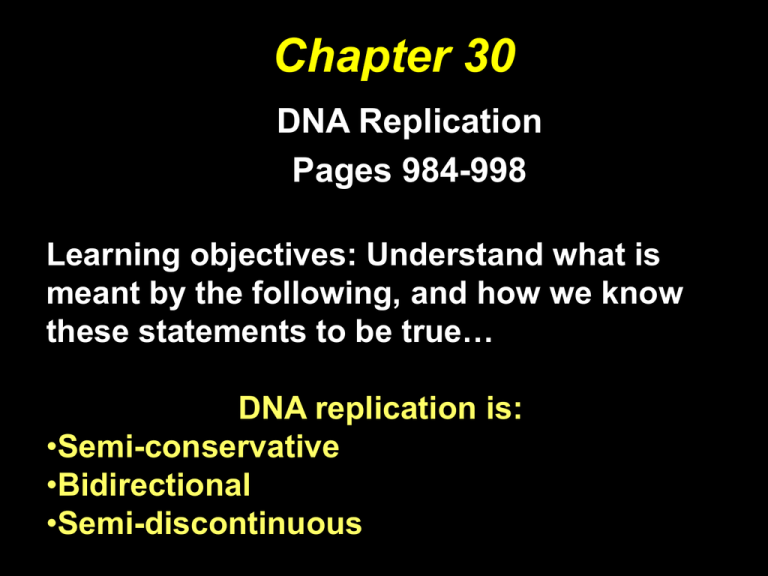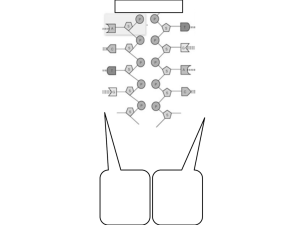
Chapter 30
DNA Replication
Pages 984-998
Learning objectives: Understand what is
meant by the following, and how we know
these statements to be true…
DNA replication is:
•Semi-conservative
•Bidirectional
•Semi-discontinuous
All rights reserved. Requests for permission to make copies of any part of the work
should be mailed to: Permissions Department, Harcourt Brace & Company,
6277
Sea Harbor Drive, Orlando, Florida 32887-6777
The Dawn of Molecular Biology
•
•
•
•
April 25, 1953
Watson and Crick: "It has not escaped our
notice that the specific (base) pairing we have
postulated immediately suggests a possible
copying mechanism for the genetic material."
The mechanism: Strand separation, followed by
copying of each strand.
Each separated strand acts as a template for the
synthesis of a new complementary strand.
This is referred to as “semi-conservative model”
Parental Strands
Strand separation
Strand
duplication
1/2 old
1/2 new
Models for DNA replication
1) Semiconservative model:
Daughter DNA molecules contain one parental
strand and one newly-replicated strand
2) Conservative model:
Parent strands transfer information to an
intermediate (?), then the intermediate gets copied.
The parent helix is conserved, the daughter
helix is completely new
3) Dispersive model:
Parent helix is broken into fragments, dispersed,
copied then assembled into two new helices.
New and old DNA are completely dispersed
Testing Models for DNA replication
Matthew Meselson and Franklin Stahl (1958)
Matthew Meselson and Franklin Stahl more recently
Faculty member at Harvard
Mechanisms of Molecular Evolution
Faculty Chair for CBW Studies
Faculty member at U. of Oregon
Meiotic Recombination
Testing Models for DNA replication
Meselson and Stahl (1958)
Density labeling experiment on E. coli (bacterial) DNA
Bacterial culture
Grow for several generations
15NH Cl
4
(Sole N source)
Bacterial culture
with dense DNA
This is the starting material for the experiment
Meselson and Stahl (continued)
Harvest cells and resuspend in media with
14NH Cl
4
as the sole N source
Bacterial culture
with dense DNA
Grow for another
generation
etc
14NH Cl
4
Bacterial culture
“0 generation”
Grow for another
generation
Harvest some cells
“2nd generation”
Grow for 1
generation
Harvest some cells
“1st generation”
For each generation isolate the DNA and spin through a density (CsCl) gradient).
Detect DNA in the gradient (eg by UV absorption)
Monitor how many DNA bands there are after each generation
Anticipated Results for each Possible Model
Gray = Heavy
orange = light
3 light, 1 heavy
i.e. two bands
2 light, 2 intermediate
i.e. two bands
4 intermediate
i.e. one band
Meselson and Stahl Original Data
DNA Replication
…Is semiconservative
• Matthew Meselson and Franklin Stahl showed
that DNA replication results in new DNA duplex
molecules in which one strand is from the parent
duplex and the other is completely new
• Since DNA replication is semiconservative,
therefore the helix must be unwound.
• Unwinding generates torsional stress (supercoils)
which must be removed by topoisomerases
(Chapter 12)
Real World Biochemistry
http://infections.bayer.com/treatment/ciprofloxacin_ciprobay_en.html
Ciprofloxacin is a synthetic bactericidal
antibiotic that inhibits bacterial DNA
synthesis, so that bacteria rapidly die.
The target is the enzyme DNA gyrase
(topoisomerase II), which is responsible
for the supercoiling and uncoiling of the
DNA. Uncoiling of the DNA is the
initiative step for replication,
transcription and repair of the DNA.
Thus, prolonged inhibition will
eventually lead to the death of the
bacteria.
CIPRO
DNA Replication
• Since DNA replication is semiconservative,
therefore the helix must be unwound.
• John Cairns (1963) showed that initial unwinding
is localized to a region of the bacterial circular
genome, called an “origin” or “ori” for short.
Replication forks
E. coli
chromosome
Localized
unwinding
origin
DNA replication
bidirectional
OR
unidirectional
John Cairns
Bacterial
culture
*T
*T
*T
*T
in media with low
concentration of
3H- thymidine
Grow cells for several generations
Small amounts of 3H thymidine
are incorporated into new DNA
*T
*T
*T
All DNA is lightly
labeled with radioactivity
Grow for brief
period of time
Add a high
concentration
of 3H- thymidine
*T *T
*T
*T*T
*T
*T
*T
*T *T
*T
*T
*T
*T*T *T *T*T *T
*T
*T
*T
*T
*T
*T
*T *T
Dense label at the replication fork
where new DNA is being made
Cairns then isolated the chromosomes by lysing the cells very very gently
and placed them on an electron micrograph (EM) grid which he exposed to
X-ray film for two months.
Evidence points to bidirectional replication
Label at both replication forks
Features of DNA Replication
• DNA replication is semiconservative
– Each strand of both replication forks is
being copied.
• DNA replication is bidirectional
– Bidirectional replication involves two
replication forks, which move in opposite
directions
Arthur Kornberg (1957)
Protein extracts from E. coli
+
Template DNA
Is new DNA synthesized??
Currently a faculty member at
Stanford School of Medicine
- dNTPs (substrates) all 4 at once
- Mg2+ (cofactor)
- ATP (energy source)
- free 3’OH end (primer)
In vitro assay for DNA synthesis
Used the assay to purify a DNA polymerizing enzyme
DNA polymerase I
Kornberg also used the in vitro assay to characterize
the DNA polymerizing activity
- dNTPs are ONLY added to the 3’ end of newly
replicating DNA
5’
3’
5’
3’
5’
3’
5’
3’
3’ New progeny strand
3’
5’ Parental template strand
5’
3’
5’
3’
5’
-therefore DNA synthesis occurs only in the
5’ to 3’ direction
THIS LEADS TO A CONCEPTUAL PROBLEM
Consider one replication fork:
3’
3’
5’
Primer
Continuous replication
5’
Direction of
unwinding
3’
5’
3’
Discontinuous replication
5’
3’
5’
Evidence for the Semi-Discontinuous replication
model was provided by the Okazakis (1968)
Reiji Okazaki was born near Hiroshima, Japan, in 1930.
He was a teenager there at the time of the explosion of the first of two
nuclear bombs that the US dropped at the end of World War II.
His scientific career was cut short by his untimely death from cancer
in 1975 at the age of 44, perhaps related to his exposure to the fallout
of that blast.
Tuneko Okazaki, until recently, was a professor at
The University of Nagoya where she was the first
woman at that institution to be named a professor.
Currently she is on the faculty of Medicine in Fujita,
and does research on centromeres.
Evidence for Semi-Discontinuous Replication
(pulse-chase experiment)
Bacterial
culture
Add 3H Thymidine Flood with non-radioactive T
Harvest the bacteria
at different times
For a SHORT time
Allow replication
after the chase
(i.e. seconds)
To continue
Bacteria are
replicating
smallest
Isolate their DNA
Separate the strands
(using alkali conditions)
Run on a sizing gradient
Radioactivity will only
be in the DNA that was
made during the pulse
largest
Results of pulse-chase experiment
Pulse
Chase
3’
3’
5’
Primer
smallest
5’
Direction of
unwinding
3’
5’
3’
largest
5’
3’
***
5’
DNA replication is semi-discontinuous
Continuous synthesis
Discontinuous synthesis
Features of DNA Replication
• DNA replication is semiconservative
– Each strand of template DNA is being copied.
• DNA replication is bidirectional
– Bidirectional replication involves two replication
forks, which move in opposite directions
• DNA replication is semidiscontinuous
– The leading strand copies continuously
– The lagging strand copies in segments
(Okazaki fragments) which must be joined
The Enzymology
of DNA Replication
• In 1957, Arthur Kornberg and colleagues
demonstrated the existence of a DNA
polymerase - DNA polymerase I
• Pol I needs all four deoxynucleotides, a template
and a primer - a ss-DNA (with a free 3'-OH) that
pairs with the template to form a short doublestranded region
DNA Pol I from E. coli is 928 aa (109 kD) monomer
- a single polypeptide that packs a punch!
DNA Polymerase I has THREE
different enzymatic activities:
• a 5’ to 3’ DNA polymerizing activity
• a 3’ to 5’ exonuclease activity
• a 5’ to 3’ exonuclease activity
The protein is folded into discrete
domains
• Hans Klenow used proteases (subtilisin or
trypsin) to cleave between residues 323 and
324, separating 5'-exonuclease (on the small
fragment) and the other two activities (on the
large fragment, the so-called "Klenow fragment”)
• Tom Steitz has determined the structure of the
Klenow fragment
The 5’ to 3’ DNA polymerizing activity
Subsequent
hydrolysis of
PPi drives the
reaction forward
DNA Polymerase I
Replication occurs 5' to 3'
• Nucleotides are added at the 3'-end of the
strand
• Pol I catalyzes about 20 cycles of polymerization
before the new strand dissociates from template
• 20 cycles constitutes moderate "processivity"
More on Pol I
Why the exonuclease activity?
• The 3'-5' exonuclease activity serves a
proofreading function
• It removes incorrectly matched bases, so
that the polymerase can try again
For Next Class:
We will finish up DNA replication
Chapter 30
Sections 30.3 30.4, 30.5, 30.6
We will NOT cover section 30.7





